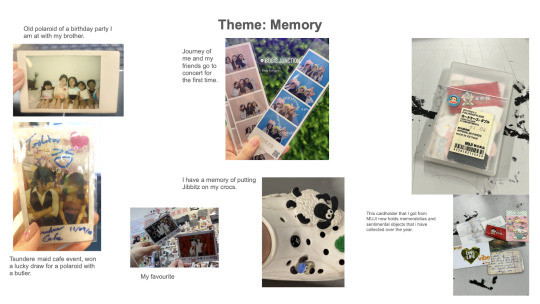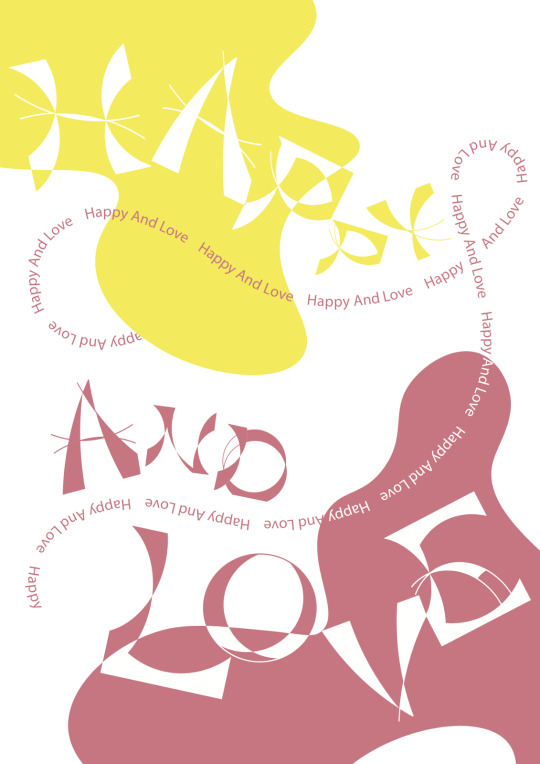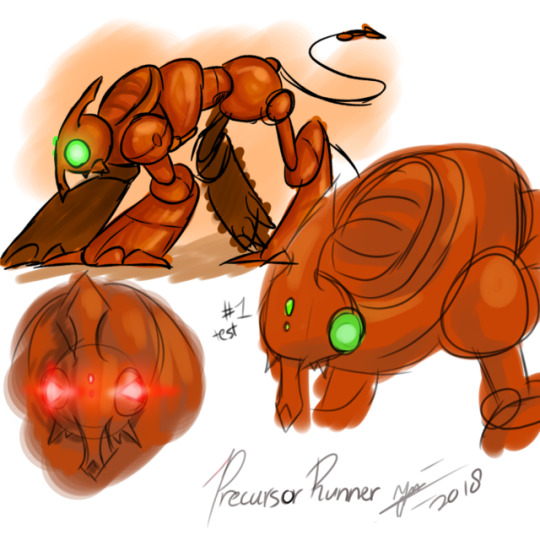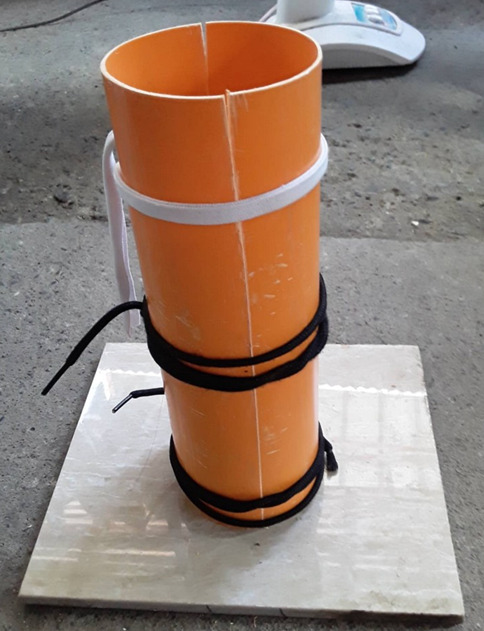#prototypr
Explore tagged Tumblr posts
Text
#github#prototypr#front-end#open-source#front end#publishing#platform#next.js#js#javascript#strapi#cms
0 notes
Note
prototypr fictive hi i used to joke abt me and jeremy being best friends but it like turned serious at some point and i genuinely miss that weird pink cube sometimes
.
4 notes
·
View notes
Text
WOII Compulsory: Week 5 & 6 - Design Analysis and Field Trip
Why should we analyze design? Every design has a reason behind it. Colors, shapes, and materials are all used to show a certain feeling or message. By analyzing why certain design choices are made in specific contexts, we can learn to apply these principles in our own work to create more intentional and effective designs.

In Week 5's activity, I analyzed the charms (Jibbitz) and categorized them under the theme of "memory" because users can personalize their shoes by choosing and placing charms as they like, creating a meaningful experience. This uniqueness gives the product a competitive edge. Personalization has been a key part of Crocs’ business strategy, and Jibbitz played a big role in boosting their revenue (Osum). At the same time, because the process is also fun and engaging, I began exploring new connections with the theme of "play" during our field trip.



Considering the features of Jibbitz, I focused on things people can directly experience and enjoy, like a knitted flower that can be gifted, a pinwheel to play with, or a decorated mirror for taking photos. What these all have in common is that people derive value from using these products. Interestingly, even though I took pictures of different objects in different places, I found common design elements when grouped under the theme of "play", bright colors and round, playful shapes. I believe these design elements were used because they evoke a feeling of joy, aligning with the shared goal of making people feel entertained.



In my craft font design class, I created a poster with the theme “enjoy,”. To express this, I used elements like ribbons and curved lines. I also chose bright yellow and pink colors that frequently appeared in the photos taken during our activity with the theme of “play.” These choices helped convey a joyful feeling. Through this design analysis, I was able to notice design principles I would normally overlook and apply them to my own work, making the design more effective.


(333 words)
References
Heft-Kniffin, Brandi Sea. "The Magic of the 'Why' in Design." Prototypr, 1 Nov. 2017, https://blog.prototypr.io/the-magic-of-the-why-in-design-12ed3f33f3e2. Accessed 9 Apr. 2025.
Designhill. "20 Tips For Young Graphic Designers." Designhill, 3 Mar. 2019, updated 18 Jan. 2023, https://www.designhill.com/design-blog/tips-for-young-graphic-designers/. Accessed 9 Apr. 2025.
Spacey, John. "Design Analysis." Simplicable, 25 Aug. 2018, www.simplicable.com/design/design-analysis. Accessed 6 Mar. 2025.
"Building a Profitable Croc Charm Business." Osum, 6 Apr. 2024, https://blog.osum.com/croc-charm-business/. Accessed 8 Apr. 2025.
0 notes
Quote
当時、私はありとあらゆる仕事に「イエス」と言っていました。私はハングリー精神があり、お金を稼ぎたかったし、クリエイティブなことは何でも楽しんでやっていました。初日から専門分野を絞りたがったり、非常に頑固なまま 1 つの役割に固執したりする新人が多すぎます。これは一部の人にとっては役立つかもしれませんが、冒険や楽しみの多くを奪ってしまいます。私が会ったデザイナーのほとんどは、自分の殻を破って、外へ出て探検に出かけました。
私のデザインキャリアを吹き飛ばしたアドバイス | Punit Chawla 著 | 2024 年 6 月 | Prototypr
0 notes
Photo





projet autour de la plante, septembre-novembre 2017
techniques multiples, carnet format 30/15cm + prototype
projet scolaire
#draw#art#student#plante#plante verte#bijou#bijoux#miroir#ombre#lumière#sketch book#design#carnet#géométraux#prototypr#maquette
1 note
·
View note
Photo

i made a own design for story i need alot to do buuut where do he come from who is the owner of the robot who knows!
#Jak and daxter#precursor#runner#own design#sketch#you can ride on it#theres big on its more faster this is first prototypre
12 notes
·
View notes
Text
day 433
has prototype! gilgamesh arrived in fgo?
if they were going to have the lwm event last for only a week, they should have chosen a better collab franchise that could have had so much story potential. just saying...
#day 433#fgo#proto! gilgamesh#gilgamesh#and by story potential i mean prototypr#*prototype#as in give us proto! gil
1 note
·
View note
Text
10 Reasons Why All Designers Should Start Writing More
The new habits you’ll start doing & the career benefits you’ll get from them.
For the past year I set a goal to start writing more, to share my knowledge with the design community. Rather than bottling them up in private journals. Since doing so, I noticed new habits developing that turned out to be very beneficial in my design career. So the following points are ones of encouragement. Here’s 10 reasons why writing more will benefit you as a designer.
1. Reasons to talk to someone you normally wouldn’t feel comfortable to.
Writing will give you a reason to talk to someone that you might otherwise feel uncomfortable to approach. It could be a lead from a different department or even someone on twitter. Its a lot easier to approach people when you’ve got a specific reason to. For example, you might ask for their insights around something you’re writing about.
In my experience, people I perceived as daunting were actually very welcoming. If you’re sparking a conversation in their interests and showing curiosity in their knowledge, they’ll be happy and excited to chat with you.
2. Dribbble shows your style, but writing reveals your mind.
They say “a picture can tell a thousand words” but thats not always the case. Dribbble and Behance are fantastic channels to show your visual design skills and style, however this isn’t enough for UX.
UX is about your way of thinking, your processes and ability to work through what I like to call ‘non-sexy problems’. So write about it, reveal your mind to the world. You never know who might be reading. Someone who wants to team up with you? Potential future employers?
3. You’ll find yourself researching more into a breath of different topics.
When I’m working on an piece of writing, I’ll usually fall into this infinite rabbit hole of googling. One topic leads to another, which leads to another. You’ll end up with an endless list of topics, articles and podcasts to absorb in your free time. This extra knowledge can spark new ideas down the track.
Tip: If you’re writing about something controversial or highly debated, it’s important to learn about both sides of the augment. This will help you make an educated and open minded comment.
4. Build trust and better communication with clients.
Even though design is a visual industry, writing will always play a vital role. Whether its writing a slide deck, a presentation, storytelling or emailing clients. Great copy will go along way as it shows competence and allows you to get the message across clearly.
If writing isn’t your forte, you can use text editors such as Hemmingway and Grammarly to check your work. The more you review your writing, the sooner it will become second nature.
5. ‘UX Writing’ will help your users.
Speaking to the point above, not only is writing useful for internal communications, but it’s a UX role in its self. Companies such as Google and Amazon employ UX writers. It’s their role to create copy that helps a user understand the task at hand.
Although, you don’t need to be exclusively employed as one to do this. Google has written wonderful guidelines for UX writing. Just having that knowledge will allow you to create better user experiences.
6. Connect with the design community.
Having a platform online opens up a new means of communication with people. Go ahead, have a little stalk of the people following you. Is there anyone interesting that you want to reach out to?
Did you really enjoy an article? Then tell them! Everyone deserves positive acknowledge for their efforts. That response might be the difference between them continuing writing or giving up. Continue to be active in discussions and engage with others.
Did a designer that you admire share your work or liked the post? Take that opportunity to reach out and say thank you. You’re allowed to fangirl over it. I certainly do!
7. It allows you to collate your thoughts in a formalised way.
Lets say you’ve scribbled down a few notes about a subject. These might be scattered across different sticky notes and pages in your notebook. Now this might not be for everyone, but I find formalised writing helpful. It allows you to collate your thoughts and document what you’ve learnt. Similar to what I’m doing right now…
8. It thickens your skin for criticism.
Its extremely hard to put yourself out there when making your work public. Theres always a risk that people may disagree with you or challenge your ideas. Yet part of being a designer is having the ability to handle criticism and take it in a constructive way.
Just remember, theres a difference between criticism and trolling. People will always say things online that they would never say to your face. Ignore them and power on with it.
9. Improve how and what you’re saying through editing, restraint and self critiques.
Writing improves how and what you’re saying, thought the art of editing, restraint and honest self critiques. What is the most value information to the readers? Whats necessary to say? What isn’t? This is useful when speaking to clients or replying to curly emails. The art of editing will also benefit your verbal communications. Lets face it, sometimes we tend to speak before we think.
10. Medium allows us to learn from others, this is your chance to give back.
I’ve learnt a lot from other designers sharing their knowledge and I’m very thankful for that. So I want to pass on the information I know to help others. This of course is easier said than done.
It takes courage to do so, and I think we all experience classic ‘imposter syndrome’ at times. But look at it from the perspective of releasing a product or showing the first iteration of a design. We’re always learning and improving.
I’ll leave you with this reminder.
You might feel as though writing isn’t worth it because there’s people out there who know way more than you. Although, there will always be people who know less than you.
The knowledge you share will be reaching at least one person in a meaningful way, so don’t worry. Write for them, and write for you. Write for the 10 reasons I’ve stated above.
I hope you got something out of this article. Please show some hearts if you enjoyed it and drop a comment if you’ve noticed any of these habits forming as well. I’d love to hear from you!
Twitter | Dribbble
While you’re here, check out 22 Things New UX Designers Should know Before Entering the Workplace
http://ift.tt/2pIip9S
10 Reasons Why All Designers Should Start Writing More was originally published in Prototyping: From UX to Front End on Medium, where people are continuing the conversation by highlighting and responding to this story.
0 notes
Text
Thinking for design
Hanul Pechuls
Caroline Kilday
Artc 1302
21 October 2019
For you to come up with an idea first you must need a problem to solve or a goal to meet. What are you trying to accomplish? Is there a better way to show this? How can I get my message across in this way? These are all questions that can get you thinking about ideas for design. Whether it be for visual or something else there always needs to be a starting place. You should really do research on how you want your idea to come across as. Once you have an idea how are you going to implement and execute that idea. Finally, how does the idea/concept read with other people?
Research is key when thinking of ideas for design. The more information you take in the more ways you are able to think of designing elements in different ways. Look for design magazines or online treads or picture galleries. One thing to keep in mind is that you are only looking for reference material and not get too attached to one thing you saw. Try looking around in your everyday life by just taking pictures or notes that you say around your daily life.
Once you have an idea you now need to put that idea into action. You have to implement your idea so that when others see it, they also get what you are trying to communicate. This process is crucial to having a successful design if you cannot execute this process the viewers that are trying to understand your design will not process it correctly and your message or idea that you were trying to communicate could be lost or skewed. If you end up getting stuck try to look back on your reference material and try to understand why and how it works.
Finally, when you have your idea cemented into a design try to get other peoples feedback to see why or why not something is working. Tey to be objective when taking in critique because they are only trying to help because if you are too close to your design you may think that there is nothing wrong and it is resolved when in reality your design could be unresolved. Keep going back and correcting and changing your design until the people you show it to understand the concept and the idea that you were trying to get across works and the audience is able to understand what is going on. By this step, your work may be resolved but there are always ways that you can improve
By following this process you should be able to get an idea of what you want to do and how you should do it. This process may not work for all but it is how I generally do thinking for design work and getting ideas for other projects. I use all my available resources around me which also involves the people/colleagues that I design with.
Works cited
DiPietro, Bianca. “Designers and Creative Thinking.” Medium, Prototypr, 6 Jan. 2018, https://blog.prototypr.io/designers-and-creative-thinking-c9ea4c958e43.
Morasky, Matt. “Design Thinking vs. Visual Thinking.” XPLANE's XBlog, https://xblog.xplane.com/design-thinking-vs-visual-thinking.
Paraschiv, Corina. “Visual Thinking in the Design Thinking Process.” Medium, Design Thinking Montreal, 13 July 2017, https://medium.com/dt-mtl-leadership/visual-thinking-in-the-design-thinking-process-d70ed4916eb9.
5 notes
·
View notes
Link
1 note
·
View note
Text
The Importance of Human-Centered Design
In today’s society, art and design are scattered all throughout the world, making it nearly impossible to escape the sight of it. In fact, we view upwards of 4,000 advertisements on average each day. Advertisements, logos, posters, packaging, and much more are all responsibilities of graphic designers. Of the different types of design, human-centered design is the type that most intrigues me due to how much it influences our behavior.
Human-centered design is quite unique compared to creative thinking and design thinking. It is a “framework that considers human perspectives throughout the design process” (prototypr.io). These designers carefully study human behavior and interaction in order to understand human nature. This understanding of human nature gives the designers insight on how to make their products efficient and effective for their clients and customers to use. When I think of how products are made to fit the needs of others, I think of it almost as a science. We have to learn what people like and do not like, what their habits are, and how this product will affect their lives.
Like any form of art and creativity, there is a process that designers must follow in order to achieve their desired product. Within the human-centered design process, there are three main steps: inspiration, ideation, and implementation (IDEO, 11). With inspiration, the designer(s) develop a better understanding of people; they study behavior, desire, and people's daily lives. Next, we move into ideation, in which we generate innumerable ideas and designs, and test which work the best. Lastly, in the implementation stage, we “figure out how to get [our] idea to market and how to maximize its impact in the world” (IDEO, 11).
Failure: everyone experiences it, and it is possibly the most crucial step when creating art and designs. Human-centered designers are very much like inventors: they “tinker and test, [they] fail early and often, and [they] spend a surprising amount of time not knowing the answer to the challenge at hand. And yet, [they] forge ahead” (IDEO, 10). Much like inventors, designers experience a significant amount of failure. Without failure, we would not be able to make improvements to our work. More importantly, we would not be able to learn new techniques and methods to help with other projects. With this gained knowledge from failure, we are able to effectively refine our designs to better fit the needs of our clients.
Human-centered design is vastly unique compared to design thinking and creative thinking due to how much time goes into research and the development of a product catered to human action and behavior. Going through the design process and following the steps of inspiration, ideation, and implementation allows designers to gather adequate information about their target audience and test their theories out with others before the final product is released in the market. During this testing phase, failure makes itself known, allowing for us to correct our errors and to learn from our mistakes. Learning from mistakes is the best lesson a designer can learn so that they may not make those same mistakes on the next project.
Works Cited
Elisia, Francesca, and Francesca Elisia. “What's the Difference Between Human-Centred Design and User Experience Design?” Prototypr, Prototypr, 20 Aug. 2017, blog.prototypr.io/whats-the-difference-between-human-centred-design-and-user-experience-design-2f48e5c9be25.
IDEO. “The Field Guide to Human-Centered Design.” IDEO.org, bestgraz.org/wp-content/uploads/2015/09/Field-Guide-to-Human-Centered-Design_IDEOorg.pdf.
9 notes
·
View notes
Link
3 notes
·
View notes
Link
3 notes
·
View notes
Text
Typora on android

#TYPORA ON ANDROID ANDROID#
Selecting multiple groups will show the combined sheets of those groups. Saved filters can be moved around to different groups and will return filtered results for that group. Filters can contain a combination of conditions and be saved to make a new group. Contents of a group can be filtered by text, keywords or change date within headings, code blocks, images or any other marked up text. Great for splitting up larger documents into manageable chunks while still keeping an overview of the whole project and having the ability to move sections around quickly. Top 10 alternatives: itch.io, Prototypr, Markdown Preview, Markdown Editor, Write.md, Looptap, Inkspired Writer for iOS and Android, Markably, StackEdit. FreeOpen SourceMacWindowsLinuxAndroidiPhoneChrome OSAndroid. Sheets can be split up, merged, glued together and easily moved around in the sheet pane by dragging and dropping. Not to worry : The best alternatives to Typora offer robust features and compatibility. Steps Put your notes in a git repo hosted online. Markdown Online Editor Typora is an incredibly simple and easy cross-platform text editor that allows you to write in Markdown source code with support for MathJax via a clean and functional interface.
#TYPORA ON ANDROID ANDROID#
My Android device screen is captured using scrcpy. /rebates/&252ftypora-android. Typora Android Tryit Editor a computer program used to create and edit web pages. Example Here's a picture of a file from my Obsidian Vault I wrote on macOS, but it's viewable and editable from Android. Groups can have an unlimited amount of subgroups and the title of subgroup shows up in the pane view. Eventually, I abandoned Typora to use Obsidian completely since I could do everything in Obsidian. It organizes content in groups (folders) and sheets (files), has a powerful, easy to use search and allows adding keywords to attachments to help them be organized and found quickly. Great tools for organizing and finding files Ulysses saves everything in the app so there's no file management outside of the editor involved.

1 note
·
View note
Text
Technopreneurship Finals Blog 5
Prototype
Prototypes are the most important thing in making business proposals. in making prototype to ensure the costumers trust towards the product.
Our team decided to gather the materials needed in making our prototype. And here are the list of the materials for our prototypr
The materials are:
Rice hulls (Passing the 2.00 mm sieve) Cement (Any brand) Gravel Sand Mold (PVC Pipe) Tamping rod (For tapping the sides of the mold or inserting it into the wet concrete so that the bubbles inside will get out)
The following photos below are the process in making our prototype.










0 notes
Text
Why writing is the most important skill in design.
Forget coding. The best designers are writers.
Design in tech matters, and companies are finally caring about design. This is especially true in software, where companies are hiring designers at an increasing rate.
But tech is changing, and as a result, the designer’s role in tech is also changing. Our daily interactions with technology are becoming less visual, like chat bots and connected devices, and as a result, visual design is becoming more obsolete. Luckily, good design is not just how it looks, but how it works and how it feels; so wireframing in Sketch or Photoshop just won’t cut it anymore.
Despite a decreasing emphasis on visual design, design isn’t going anywhere and it will maintain its importance over time if designers learn to adapt. Most design leaders, like John Maeda in his Design in Tech Report, argue that designers need to code in order to survive. But if you’re a young or aspiring designer, I’m here to tell you, to beg you, to ignore these people.
Design is about people, not technology. In order to design great products, you need to understand not just what you’re making, but why you’re making it. You do that by empathizing with your customers to feel their pain, and designers are effective only after doing so.
Like designers, great writers understand their audience. They do their research, because the plot and character development has to be believable, complete, and without gaps. They develop empathy for the main characters, fiction or non-fiction; understanding not just who they are, but how they became the way they are.
The context of use for something you’d make for a gardner is very different than for a neuroscientist.
The parallels between writing and designing are strongest when it comes to building context. Both require sensitivity to every plausible situation. Like writing, the design process considers varying levels of complexity in the context of use:
Emotional Context. How does someone feel when they are using your product— not just during, but before and after. What’s their mental state; are they using your product to aleviate boredom or are they using your product during a medical emergency?
Environmental Context. Where are they when they’re using your product? What are they doing with their hands? What else is fighting for their attention? Do they have time constraints? Are they using your product while driving or are they using it at their cubicle?
Social Context. How will they be perceived by others when using your product? Will it make them feel cool or proud? Or do they need your product to help them with a problem that’s too embarassing to share with others?
The answers to those questions will inform significant decisions around what a product does, how it looks and how it will be used. For example, it doesn’t matter what tech stack or programming language Snapchat is using, if I can’t get to my camera view in under 3 seconds to capture a fleeting moment, it becomes much less useful and valuable to me.
It’s really important to maintain that context every step of the way and hold true to it throughout the product development lifecycle. Great designers understand how to articulate and summarize context of use. They know how to share that story with other stakeholders so that product teams can have clear alignment. Sharing intimate details of the customer’s story allows the entire company to empathize with and rally around the customer’s pain points.
Whether it’s in the form of personas, storyboards, journey maps or even a plain old written narrative, great designers start with clear, compelling narratives about the context of the customer’s problem they’re solving for. Like storytelling, every design project has one or more protagonists, a setting, a plot, a conflict and a resolution. Both writers and designers arrive to the resolution in similar ways.
Granted, learning to code can help designers make technical decisions that impact usefulness. For example, Instagram, in it’s infancy, couldn’t afford to allow for both landscape and portrait mode, so the designers decided to make every posted photo a perfect square. It was a smart design decision because it meant you didn’t have to choose which way to take your photos. The designers could not have made that decision without a working understanding of code, so there’s a serious case to be made for designers who can code.
But at the end of the day, if you lose sight of the end-user, none of that matters. What companies need now and in the near future are designers that are writers and storytellers. Good writing skills enable designers to tell a strong narrative of the customer in a holistic, memorable way. The result is thoughtful design; creating products that people love and can’t live without.
Do you agree? Recommend 💚 or share this article if you do. Otherwise, leave a comment and let me know what you think is more important.
http://ift.tt/2pIip9S
Why writing is the most important skill in design. was originally published in Prototyping: From UX to Front End on Medium, where people are continuing the conversation by highlighting and responding to this story.
0 notes